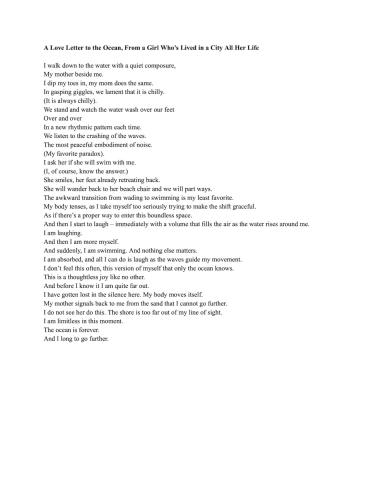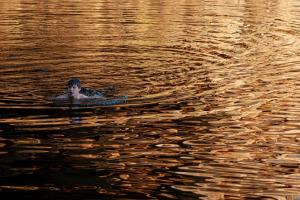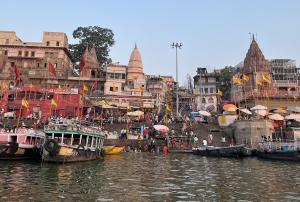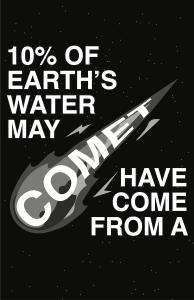An exhibition to collectively address bodies of water as fellow beings on this Earth and to cultivate care for watersheds.
The Dear Body of Water initiative invites people everywhere to write postcard-sized love letters to recognize beloved rivers, oceans, aquifers, creeks, ponds, and other bodies of water.
Georgetown University’s Dear Body of Water exhibition will "grow the flow" by incorporating visual and written artwork by Georgetown students to collectively address bodies of water as fellow beings on this Earth. The Library is partnering with GREEN (Georgetown Renewable Energy and Environmental Network) to showcase works of art, poems, and love letters to bodies of water.
Following the project's prompts, student art explores questions such as:
- How does water melt into our histories, memories, dreams, griefs, hopes, and presence?
- What bodies of water are overlooked or neglected?
- More than water rights, how can we consider the rights of water?
Water is treated as an economic resource, yet it is animated and animating. The act of collectively addressing bodies of water as living beings (as in, Dear Body of Water) hopes to reframe water in the climate crisis by focusing not on floods, droughts, rising sea levels, or retreating rivers, but instead on the love and respect we have for our waterways. Through this love, we can begin to show our care for water by making changes to protect it and to improve our earth.
Join us as we address the bodies of water and watersheds that replenish our lives—across the planet—to grow a global chorus. Wherever we are, the chance to hear personal perspectives about bodies of water helps connect us to our planet’s lifeblood: water.
THE OPENING RECEPTION FOR THIS EXHIBITION WILL BE ON WEDNESDAY, APRIL 23 FROM 4:00-5:15 PM.
Königssee Triptych
Anonymous, CAS ‘25
2024
Photograph
This triptych showcases the majesty of Königssee (King's Lake) in Berchtesgaden, Bavaria.
A Love Letter to the Ocean, From a Girl Who’s Lived in a City All Her Life
Madeleine Callender, CAS '26
2024
Poem

The River's Embrace
Ksenia Dubova, SFS ‘25
2019
Photograph
The photo was captured on an extremely hot day in Kyiv, Ukraine, where a group of teenagers sought relief in the cooling water of the Dnipro River. I could not pass them by as they radiated so much joy. After the sunset, the water turned into a stunning golden color, and I thought: this river reflects nature – impacted by change, yet still embracing us.
The Blueprint of Wonderland
Katie Shen, CAS '28
2025
Watercolor and ink
As an artist and aspiring molecular biologist, I find inspiration in nature’s evolutionary solutions. Biomimicry applies these mechanisms to solve modern challenges like climate change. In my storybook-style work, inspired by Alice in Wonderland, diverse ecosystems collide in a dreamlike journey. By exploring biomimicry and interconnected ecosystems, we can shift from exploitation to restoration and innovation.
Waterfall
John Matuszewski, SFS ‘25
2023
Digial Photograph
This waterfall was on the property of a cattle rancher in Guacimo, Costa Rica who converted his ranch into an ecotourism attraction at the insistence of his wife. He gradually came to like the idea, and much of his property was reforested as a result. My roommate at the time leaped from a small cliff next to the waterfall into a deep pool below and I captured his jump mid-air.
Overlooking Havana
Caitlin McBride, CAS ‘25
2023
Oil on Canvas
Altitude causes the perception of a higher horizon; from the top of the Iglesia Del Sagrado Corazon de Jesus in Havana, Cuba, the ocean nearly seemed taller than the city. The visibility of the life and buildings in the city brings to mind the life and activity under the Caribbean Sea and the North Atlantic Ocean surrounding Havana.
Equilibrium
Stella Vie Peters, CAS '25
2021
Photograph
Traversing 5th Avenue in summer, you never know what you'll find. The MET offers intrigue, but the world lives outside—students, tourists, food stands, taxis, musicians, dancers. The crowd changes each season, infusing life into the city. Heat, movement, and water blend in a living exhibit, where the fountain's aquatic projections bring the museum into the streets. I am exploring our relationship with water as heat changes the nature of summer.
Sailboat at Anan Bay
John Matuszewski, SFS ‘25
2023
Digital Photograph
I was working 30 miles by boat or seaplane outside Wrangell, Alaska when I took this photo. The landscape was serene; the temperate rainforest climate meant fog would ceaselessly collect over the inlet in front of my house. On some days, the tides lowered the sea 21 feet, exposing kelp, barnacles, and mussels to the air. Pictured is a boat anchored in the inlet with a juvenile bald eagle overhead.
Ghats of Varanasi
John Katial, CAS ‘25
2023
Digital Photography
Varanasi is a deeply sacred city. There is an incomprehensible array of spiritual traditions and practices occurring in unison. Pictured are the ancient ghats of Ganga, a Goddess embodied in the river birthed in the Himalaya. Along these ghats, temples and homes are fused together into a chaotic and breathtaking tapestry. Varanasi is where the found go to disappear and the lost go to be found.
1/10,000
Caitlin McBride, CAS ‘25
2023
Acrylic Paint on Canvas
In Minnesota, the majestic "land of 10,000 lakes," each lake provides beauty, peace and home to people, animals and plants alike. Regardless of one's thoughts of normal hitchhikers, the aquatic variety perpetrate the invasion of non-native species that quickly veer lakes into trouble. This lake is painted at rest, a state at which I hope we can continue to maintain it.
By the Docks
Hannah Chu, CAS '27
2023
Watercolor on Paper
The ocean has always been both a lifeline and a quiet presence, giving without asking in return. While it sustains coastal communities, modern life keeps pulling us further away. In a world of distractions, do we still see the water that sustains us? This piece explores how we depend on water, how we overlook it, and how we might begin to notice again.
Guna Yala
John Matuszewski, SFS ‘25
2023
Digital Photograph
This picture was taken on Achutupo in Guna Yala Comarca, Panama. With a population density of 15,860 people per square kilometer, it's one of the most densely populated islands in the entire world. Achutupo proves extremely reliant on tourism and fishing. Unfortunately, as a result, the coral reefs around the island are under threat from coral bleaching, coral mining, overfishing, and overtourism
A Bright Path
John Katial, CAS ‘25
2024
Digital Photograph
This image was taken in a mangrove thicket in the Florida Everglades. As I raised the camera to capture the morning light filtering through the sinewy branches, large tropical mosquitoes feasted on exposed skin. Sulfuric fumes wafted from the peat-like mud banks. This was juxtaposed with the forest’s stunning beauty and productivity. Mangroves are a nursery for hundreds of fish and seabird species.
Melting
Sofia Madden, CAS ’28
2024
Graphic Design
This piece was a project for my graphic design class. We had to make posters with a fact about water; I was inspired by my interest in environmental science, especially the ocean. I wanted to make my fact about rising sea levels to bring awareness to the melting of the glaciers. I believe the intersection of art and science is a great way to convey scientific information to a broader audience.
Poseidon's Caprice
John Katial, CAS ‘25
2024
Digital Photograph
Taken near Miami, this image carries a double meaning. The smooth blanket of waves depicts the welcoming embrace of the sea. However, the sheer force of a small wave slamming against the granite boulders reminds us that respect is a necessity. The ocean provides vital ecosystem services, yet human actions threaten marine ecosystems. This image is the ocean’s dual message of welcome and warning.
Swans on Lake Jarun
Anonymous, CAS ‘25
2024
Photograph
Swans on the surface of Lake Jarun in Zagreb, Croatia.
Beautiful Swimmer (Blue Crab)
Caitlin McBride, CAS ‘25
2023
Stained Glass
The blue crab, or the "beautiful swimmer," is one of many species in the Chesapeake Bay threatened by overharvesting, habitat loss, and water quality changes. Restoring and protecting the bay that houses this species is critical to maintain these ecosystems. My thanks to two friends who made this possible: one, with the crab, and another, with the glass.
Imagined Rivers
Katherine Wijenaike-Bogle
2025
Photography, Fabric
This piece was inspired by Washington D.C.’s “hidden rivers”: the network of rivers that have been buried underneath the streets and buildings of the city. Designer David Ramos of the website Hidden Hydrology created a map estimating the locations of streams that have since been covered by construction. What if we defined Washington D.C. by its rivers and creeks, rather than its buildings and streets? The white applique section represents the Potomac River, the Anacostia River, and Rock Creek. In contrast, the hand-quilted stitches represent the ancient rivers that once provided ecosystem services for the human and non-human world. While the white fabric representing the major waterways may be more obvious to the human eye, it is the “hidden rivers” that actually hold the quilt together.
This piece was produced as part of the “Maker in Residence” program funded by Lauinger Library. The physical quilt can be seen on Floor 1 of Lauinger Library, with additional information on the making of the quilt. Visitors are invited to touch the physical quilt!
Imagined Rivers
Katherine Wijenaike-Bogle
2025
Wood
You are welcome to run your fingers along this map! Feel the topography of Washington D.C. and the surrounding regions: at this scale, the hills and rivers become monuments. This map was created by downloading a digital elevation model from the U.S. Geographic Service, which I then converted into a CNC machine file using the software QGIS. Viewers are invited to ponder the contrast between the high-tech tools used to create the wooden map vs. the older techniques used to make the Imagined Rivers quilt. Perhaps, in the future, technology and artisanal traditions can co-create a world where humans and nature thrive next to each other as well. This piece was produced as part of the “Maker in Residence” program funded by Lauinger Library; to see other pieces produced as part of this program, check out the display cases on the fourth and first floor of the library.
Dear Body of Water is a poetic water-harvesting project founded and facilitated by Gretchen Ernster Henderson in partnership with the University of Arizona Poetry Center, Wick Poetry Center at Kent State University, and the National Coalition of Poets for Science. Learn more at: dearbodyofwater.poetsforscience.org.
The Library is also grateful to Elyza Bruce, Madeleine Callender, Beth Marhanka, and members of Georgetown Renewable Energy and Environmental Network (GREEN), Katie Merrill, and Heidi Pan for curating this student exhibit.





















